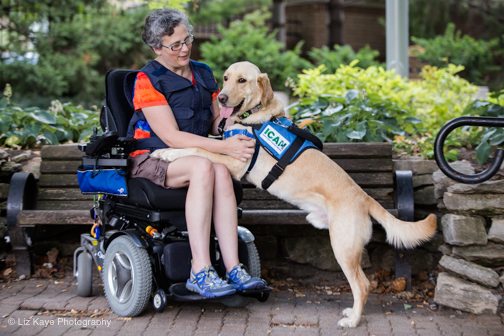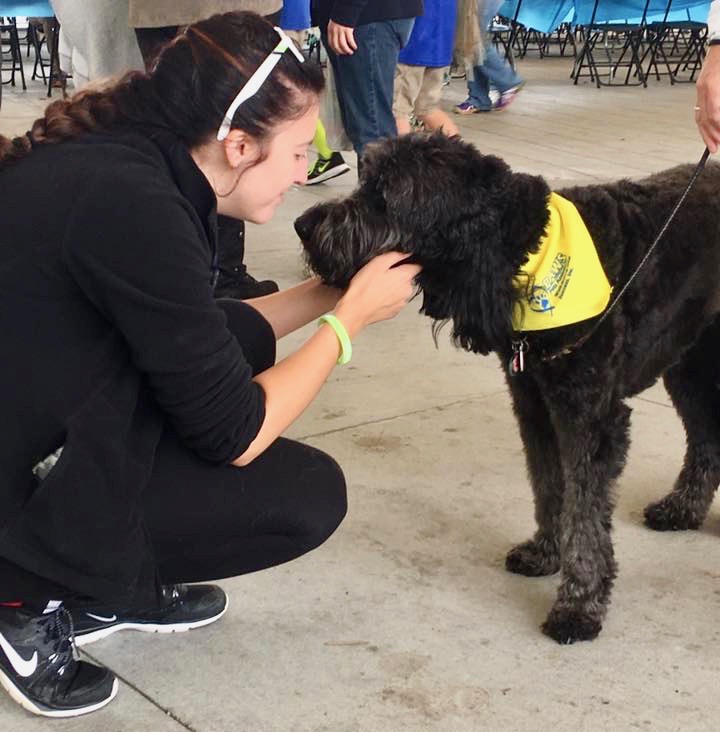
Bandit, shown here with Kristine, is a trained service dog at work — not a therapy or emotional support dog. (Photo by Liz Kaye Photography/Indiana Canine Assistant Network (ICAN).
While doing research and interviews for a magazine story on therapy animals a few years ago, I learned the important legal and functional differences between therapy animals and service animals. Now emotional support animals have entered the mix, and sometimes the headlines. What distinguishes one from another, and what does it mean for us and our animal companions?
Let’s start with a brief breakdown. The American Veterinary Medical Association summarizes each category with legal chapter-and-verse citations, and Pet Partners has a useful downloadable chart with the roles and rights of each.
Service animals
Service animals, or assistance animals, are specially, individually trained to assist or perform tasks for people with physical, sensory, psychiatric, intellectual, or other mental disabilities. This training comes from organizations such as the Indiana Canine Assistant Network (ICAN), which is the only accredited service dog training program in the state.
These are the dogs who help the blind navigate streets and shopping malls, alert someone with epilepsy of an oncoming seizure, or retrieve keys dropped by a person in a wheelchair. According to the Americans with Disabilities act, the tasks the animal performs must be directly related to the person’s disability in order for the animal to be classed as a service dog.
Yes, a service animal basically means a service dog — but miniature horses can be service animals if they are housebroken, under the handler’s control, and can be accommodated by whatever facility the handler wishes to enter. Under the ADA, service animals are allowed just about anywhere as long as they do not directly threaten public health or safety.

Ellie, a therapy dog with PAWS, Inc. (Pets Assisting Well-Being and Success), visits with an attendee at Fort Wayne’s Out of the Darkness walk for suicide prevention. Ellie and her human, Venita Lawyer, have worked in a variety of school and clinical settings. (Photo by Venita Lawyer/PAWS, Inc.)
Therapy animals
These are the dogs who, with their (usually volunteer) handlers, go from room to room in hospitals or listen to children read in libraries. They hang out in student commons areas during finals week and are becoming more common sights in airports.
My understanding is that most therapy animals do not undergo training (apart from canine “good citizen” classes), but they and their handlers are often members of groups such as the Alliance of Therapy Dogs or Fort Wayne’s PAWS, Inc., which works with Alliance of Therapy Dogs-registered dog handler teams.
Obviously, “therapy animals” has applied mostly to dogs. However, horses who are part of specialized riding or equine-assisted counseling programs, such as the ones at Summit Equestrian Center, are also considered therapy animals.
Then there are the resident cats in hospice wings, the birds greeting nursing home visitors in the lobby, and other animals with no training or organizational affiliation whatsoever … but somehow they became therapy animals. But none of the above carry the legal status or rights of access that service animals have.
Emotional support animals
ESAs may be of any species, but are most often dogs, and receive no specialized training. Their use is supported (or prescribed) by a mental health professional stating that the animal’s presence is necessary to treat an impairment that substantially limits one or more life activities.
ESAs do not have the same rights of access as service animals. They can accompany their people into restaurants only with permission of the owner/manager. However, under the Fair Housing Act, they may live in housing with “No pets” policies and travel in the cabins of airplanes with whatever documentation the airline requires.
Interestingly, the Air Carrier Access Act seems to treat psychiatric service animals and ESAs about the same, according to the U.S. Department of Transportation, but many of the particulars are up to the airline.
Where the lines blur
I think there is better clarity now between therapy animals and service animals. However, the distinction between a service dog for someone with a mental or psychiatric disability and an emotional support animal seems murky, as does the distinction between an ESA and a companion animal. The result is misunderstanding and often fraud.
You can go online, pay a fee, and get your dog “certified” or “registered” as an emotional support animal — never mind working with a doctor or therapist — at any number of websites. You can buy official-looking service dog harnesses, emotional support animal cards, and the like online, too (including from the popular Chewy).
If you want to get around a landlord’s pet deposit or no-pets rule, take your dog onto a plane for free, or bring him into a place where pets wouldn’t normally be allowed — and you’re willing to lie about your need and the animal’s credentials — it’s pretty easy to do. That may get you what you want, but it does so at the expense of people who have worked through legitimate channels to address their needs. It inevitably does so at the expense of the animals, too.
There have been headline-making incidents of things going horribly wrong with ESAs, their people, and others, especially in air travel. Would these things have happened if the animals involved were properly trained service dogs? Some airlines are changing their policies as a result. New laws, including in Indiana where I live, are beginning to better define emotional support animals and crack down on misrepresentation.
Working with integrity
Official distinctions may be lost on animals, but many are wonderfully clear on what they are here to do, and for whom. We can help them carry out their missions, and support other animals in finding theirs, by using good judgement about what we ask them to do and listening from the heart when they tell us.
By staying informed about the above, and all the other capacities in which humans and animals work together, we can help create a world that is more fair to the animals, the people they would aid and accompany, and the animals and people affected by their presence. There is so much we humans and animals can do and be together. If we do our work with integrity, as the fourth Reiki precept puts it, we can go a long way in helping animals do theirs.
